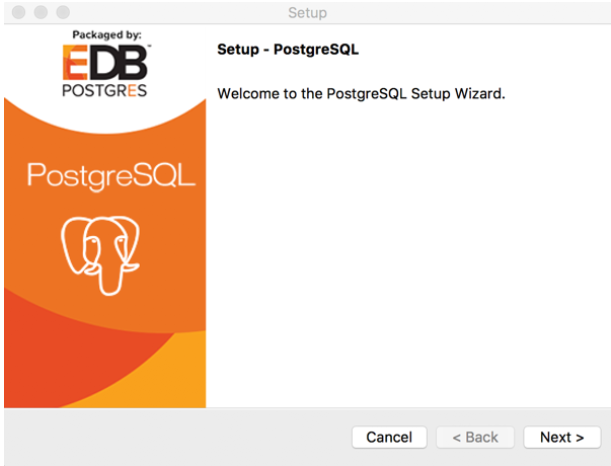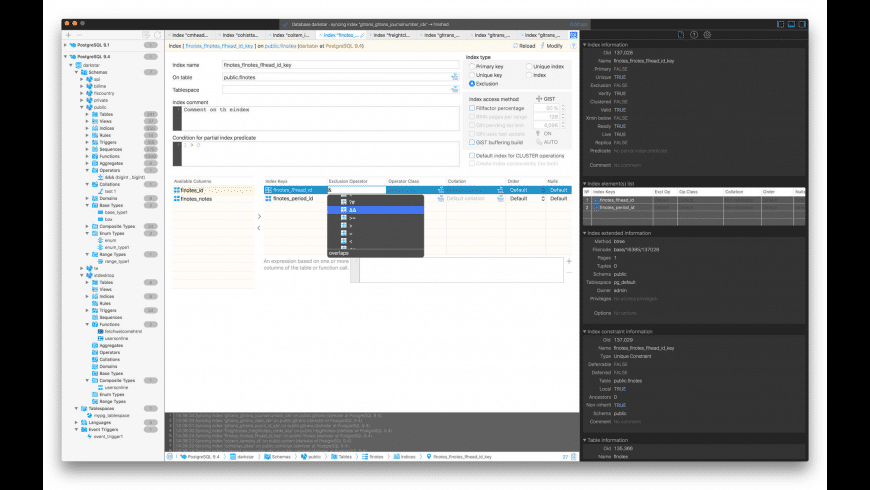You can get macOS PostgreSQL packages from several different sources.
PgAdmin 4 is a feature rich open source PostgreSQL client. It has support for almost every feature in PostgreSQL. The only downside is that the cross-plattform UI really doesn’t live up to the expectations of a native Mac app. Postico on the other hand, is a very modern Mac app. It’s made by the same people that maintain Postgres.app,. SQLPro for Postgres is a sequel pro like database application for editing and viewing PostgreSQL databases on mac os x. Homebrew users can just run “brew install postgis” and tends to be a favorite for more advanced users since there are brew scripts for most of the popular PostgreSQL extensions, not always present in other Mac distributions. The EnterpriseDb OSX PostgreSQL combination from EnterpriseDB includes generally latest stable minor version of PostGIS. PostgreSQL 13.0 Installation Guide PostgreSQL 13.0 Language Pack Guide. PostgreSQL is the world’s most advanced open source database and the fourth most popular database. In development for more than 20 years, PostgreSQL is managed by a well-organized and highly principled and experienced open source community. PgAdmin 4 (macOS) Download. Maintainer: pgAdmin Development Team A macOS App Bundle containing the pgAdmin 4 Desktop Runtime and Web application is available for macOS 10.12 and above.
Interactive installer by EDB
Download the installercertified by EDB for all supported PostgreSQL versions.
This installer includes the PostgreSQL server, pgAdmin; a graphical tool for managing and developingyour databases, and StackBuilder; a package manager that can be used to download and installadditional PostgreSQL tools and drivers. Stackbuilder includes management,integration, migration, replication, geospatial, connectors and other tools.
This installer can run in graphical, command line, or silent install modes.
The installer is designed to be a straightforward, fast way to get up and running withPostgreSQL on macOS.
Advanced users can also download azip archiveof the binaries, without the installer.This download is intended for users who wish to include PostgreSQL as part of another application installer.
Platform support
The installers are tested by EDB on the following platforms. They will generally work on newer versions of macOS as well:
| PostgreSQL Version | 64-bit macOS Platforms |
|---|---|
| 13 | 10.13 - 10.15 |
| 12 | 10.12 - 10.14 |
| 11 | 10.12 - 10.14 |
| 10 | 10.10 - 10.12 |
| 9.6 | 10.10 - 10.12 |
| 9.5 | 10.8 - 10.10 |
Postgres.app
Postgres.app is a simple, native macOS app that runs in the menubar without the need of an installer. Open the app, and you have a PostgreSQL serverready and awaiting new connections. Close the app, and the server shuts down.
Homebrew
PostgreSQL can also be installed on macOSusing Homebrew. Please see the Homebrewdocumentation for information on how to install packages.
A listof PostgreSQLpackages can be found using the Braumeister search tool.

MacPorts
PostgreSQL packages are also available for macOS from theMacPorts Project. Please see theMacPorts documentation for information on how to install ports.
A list ofPostgreSQL packagescan be found using the portfiles search tool on the MacPorts website.
Fink
PostgreSQL packages are available for macOS from theFink Project.Please see the Fink documentation for information on how to install packages.
A list ofPostgreSQL packagescan be found using the package search tool on the Fink website.
There are two main ways to install PostgreSQL on mac OS X.
- Downloading the app file from postgresapp.com.
Using Homebrew
Homebrew can be installed by running the following command in a terminal:
/usr/bin/ruby -e '$(curl -fsSL https://raw.githubusercontent.com/Homebrew/install/master/install)'
If Homebrew is already installed, make sure that it is up to date by running:

brew update
Then ensure there are no conflicts or errors using:
brew doctor
Homebrew is a powerful package manager with many uses, including installing and running postgreSQL. This can be done by typing the following command into a terminal:

Now that postgres is installed the default server can be started by running the command:
This will start up a postgres server hosted locally on port 5432. The server will be run out of the directory /usr/local/var/postgres.
It can now be accessed by typing the following command:
This will connect to the server and access the postgres database. Once this is done:
- Schemas and tables can be created
- Data can be loaded and deleted from the database
- Queries can be run
The process should look like this:
This shows that the server has been started and can be connected to.
(Optional) Creating a Custom Data Directory
A custom data directory can also be used for a server. To do this, first create a directory to be used as the server location. For example, create a directory called myData in the home directory:

Once the directory is created, the server can be initialized. This means that we configure the directory and add the necessary files to run the server. To do this run the initdb command as shown:
This will fill the myData directory with files necessary to run the server:
Now that the server is initialized and the log file is created, you can start the server from this directory. To do this use the command and substitute in for the specified values:
The “Data Directory” refers to the directory that was just initialized (in this case myData). The “Log file” is a file that will record server events for later analysis. Generally log files are formatted to contain the date in the file name (e.g. “2018-05-27.log” or “myData-logfile-2018-05-27.log”) and should be stored outside of the database that they are logging so as to avoid unnecessary risks. Log files can be dense to read but are very useful for security and debugging purposes:
The command above will generate a log file like the one shown, start the server, and tie the log file to the server. If a log file is not specified, events will be logged to the terminal:
The server will only start if the port is free. If the default server is running it must first be stopped using the pg_ctl -D /usr/local/var/postgres stop command:
Once started, it can be connected to the same way as before using:
Using PostgreSQL App
To run a server through the postgres app, the first step is to download the program. The app can be downloaded on postgresapp.com. Once the app is downloaded and moved into the applications folder, the app can be opened.
Open the Postgres app:
In order to start the server, click the start button.
This will start the server. Details on the server can be found by opening the server settings:
This interface shows all the essential information regarding the server. It also allows the port to be changed very easily. This is useful because multiple PostgreSQL servers can
Note: To change the port in the terminal, the ‘postgres.conf’ file (which can be found in the data directory) must be edited. This looks like the following:
Using Terminal with the PostgreSQL App
Once the app has been downloaded, command line tools can be used as well. These tools can be accessed by typing:
For example, the ‘postgres’ database on the server can be connected to using the psql tool with postgres as an argument:
Rather than typing out the full path each time however, the path can be added to a file that will allow significantly easier access to the tools, allowing the tools be accessed from any directory on the computer. To do this, the following command can be run in the terminal:
Postgre For Mac Download
Once this is done, the ‘postgres’ database can be accessed by simply typing:
Mac Os Install Postgresql
Summary

- Homebrew:
- Download/update Homebrew
- Use Homebrew to install postgres
- (Optional) Create New Data Directory
initdb
- Start Server
- App:
- Download app and move to Applications
- Run App
- (Optional) Set different port for multiple servers
- Start Server
- (Optional) Add path so that command line tools are easy to access
Postgre For Mac Shortcut
References
Psql For Mac
Written by: Matthew Layne
Reviewed by: Blake Barnhill , Matt David
